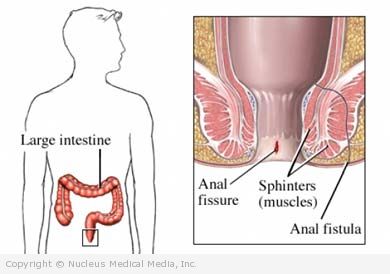Anal sphincterotomy
(Sphincterectomy, Anal; Surgery for Anal Fissures; Lateral Internal Sphincterotomy; LIS)
Anal sphincterotomy – Definition
This is a procedure to treat anal fissures. An anal fissure is a painful tear in the lining of the anus. The anus is the opening through which stool passes from the body. Tears generally occur just inside the opening.
Anal sphincterotomy – Reasons for Procedure
Muscle spasms in the rectum can prevent fissures from healing. A sphincterotomy relieves these muscle spasms. Anal fissures often heal by taking certain steps, such as:
- Eating a High-fiber diets
- Drinking plenty of fluids
- Using stool softeners
- Taking warm baths
- Using topical medicines (applied to the skin)
When these do not work, a sphincterotomy may be done. This procedure allows the fissure to heal and decreases pain and spasms. It is usually very effective. Pain will begin to go away within a few days.
Anal sphincterotomy – Possible Complications
Complications are rare. But, no procedure is completely free of risk. If you are planning to have a sphincterotomy, your doctor will review a list of possible complications, including:
- Leakage of gas or stool from the rectum
- Adverse reaction to anesthesia (eg, light-headedness, low blood pressure, wheezing)
- Infection
- Bleeding
- Abscess or fistula formation
Factors that may increase the risk of complications include:
- Smoking
Discuss these risks with your doctor before the procedure.
Anal sphincterotomy – What to Expect
Prior to Procedure
Before surgery, your doctor may do the following determine the extent of your fissure:
- Physical exam and health history
- Digital rectal exam — The doctor inserts a lubricated finger into the anus and feels for lumps or abnormalities.
- Anoscopy — A tool is inserted in the anus to allow the doctor to examine the anal canal.
In the days leading up to the surgery, your doctor may:
- Ask you to take steps to clean out your bowels.
- The day before the surgery:
- Eat a light breakfast and lunch.
- Drink clear liquids only after lunch. Clear liquids include items such as water, broth, juices without pulp, popsicles, and clear Jell-O. Talk to your doctor about which liquids are allowed.
- The night before surgery:
- Do not eat or drink after midnight the night.
- You may also be asked to give yourself an enema to help clean out your bowel. This is a fluid that is introduced into the rectum to stimulate bowel movements.
- The day before the surgery:
You should also talk to your doctor about your medicines, herbs, and dietary supplements. You may be asked to stop taking some medicines up to one week before the procedure, like:
- Aspirin and other nonsteroidal anti-inflammatory drugs (eg, ibuprofen, naproxen)
- Blood-thinning drugs, such as warfarin (Coumadin)
- Anti-platelet drugs, such as clopidogrel (Plavix)
Anal sphincterotomy – Anesthesia
Depending on which option is best for you, your doctor may give you:
- Local anesthesia — This will only numb the rectal area.
- General anesthesia — You will be asleep during the surgery.
Anal sphincterotomy – Description of Procedure
If there are any skin tags near the fissure, they will be removed. Next, the doctor will carefully make a cut on the anal sphincter muscle. This will relax the sphincter and allow it to stretch, taking pressure off the fissure. The doctor will put a dressing into your anus to stop the bleeding.
Anal sphincterotomy – How Long Will It Take?
Less than one hour
Anal sphincterotomy – How Much Will It Hurt?
During the procedure, pain will be managed with a general or local anesthetic. The pain from your fissures will begin to go away in a few days. Your doctor may prescribe pain medicine to help you feel more comfortable.
Anal sphincterotomy – Post-procedure Care
At the Care Center
You may be given pain medicines and instructions for how to care for your rectal area. A nurse may change your dressing or instruct you on how to change it.
At Home
When you return home, follow your doctor’s instructions for a smooth recovery, such as:
- Keep your rectal area clean:
- Remove your dressing before having a bowel movement.
- Take a sitz bath 3-4 times a day and after each bowel movement. Sitz baths will help relieve discomfort and clean the area. For a sitz bath, sit in warm water for 10-15 minutes. Pat the area dry. Do not wipe or rub. Devices are available to place on top of the toilet to make this process easier.
- For a few days, use alcohol-free baby wipes rather than toilet paper to wipe after bowel movements.
- You will have reddish-yellow drainage from your rectum for a week or more. Use sanitary pads to absorb the drainage. You may have increased bloody discharge after activity or bowel movements.
- If you are taking pain medicine, you may need to take a stool softener to prevent constipation. Eating a high-fiber diet can also prevent you from becoming constipated.
- Avoid sitting or standing for more than one hour at a time.
- For the first six weeks, do not lift anything heavier than 10 pounds (4.5 kilograms).
- Resume sexual activity when you feel comfortable.
- Check with your doctor to see when you can return to work
Anal sphincterotomy – Call Your Doctor
After arriving home, contact your doctor if any of the following occurs:
- Large amounts of bleeding from the rectum
- Fever
- Foul-smelling drainage from the rectum
- Excessive swelling in the rectal area
- Unable to control bowel movements
- Difficulty urinating
In case of an emergency, call for medical help right away.

